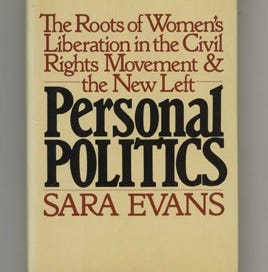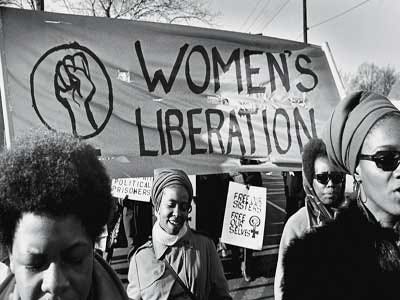Sarah Evans, Black Feminism, and Women’s Liberation
Sarah Evans’ 1979 book, Personal Politics: The Roots of Women’s Liberation in the Civil Rights Movement & the New Left, describes the development of the women’s liberation movement out of the civil rights movement of the early 1960s in the United States. Evans argues that the struggle for equality and rights in the South by black Americans and their white allies served as a jumping off point for the drive for women’s rights that women engaged in during the mid to later 1960s. Her book is an important one, because it places itself chronologically between the beginning of feminism in general and its wide acceptance and legitimacy nowadays, and between the beginning of Women’s and African American Studies in schools and their widespread application in culture and politics today. Finally, her book marks a beginning point in the study of black feminism in the black and women’s liberation movements. To delve deeper into the impact of Evans’ work of this time period and these two movements, two articles, one from 1977, and one from 2002, serve to illuminate the importance of her work.
In 1977, Diane K. Lewis published her article “A Response to Inequality: Black Women, Racism, and Sexism” in the academic journal Signs. “A Response” highlights the experience of black women in the black and women’s liberation movements. Rather than simply experiencing oppression because of their race or sex individually, Lewis argues, black women experienced both these oppressions simultaneously. Therefore, it was problematic for black women to involve themselves in the women’s movement, which was, in the beginning, dominated by white women, whose experiences of discrimination did not involve the added burden of racial hatred. Black women, despite their affinity with white women in terms of gender, were nonetheless subordinate to them, because white women had access to authority and power which black women lacked. A women’s movement within the black community therefore needed to recognize and accept its roots in racial oppression. Both black men and women were excluded from the dominant white culture, and, Lewis argues, because of this sharing of exclusion, more egalitarian sex relations grew in the black community, far more so than in the community at large.
In 2002, V. P. Franklin published the article “Hidden in Plain View: African American Women, Radical Feminism, and the Origins of Women’s Studies Programs, 1967–1974” in The Journal of African American History. Franklin’s argument is that the connection between the Civil Rights Movement and women’s liberation that Evans established in Personal Politics has had an effect on the academic study of women’s rights and history. Franklin takes this analysis further by connecting the black women’s movements of the 1970s to the academic discipline of Women’s Studies. Due to institutional racism, Women’s Studies excluded the experiences of women of color. With time and as a result of the influence of radical black feminists such as Angela Davis and Alice Walker, Women’s Studies programs incorporated courses on women of color and lesbians, but for many African American women, this was not enough, and there has recently been a call for courses in Africana Womanism.
Sarah Evans writes in Personal Politics that the roots of women’s liberation are found in the work of women in the Civil Rights Movement of the early 1960s and their experiences in the New Left movement later in the decade. Evans relies mainly on the experiences of white women in the movement (to her credit, she defuses a lot of potential criticism by noting this in her Acknowledgements), and not so much on the experiences of people, and women in particular, of color. The Civil Rights Movement was, says Evans, a time and place for women in the early 1960s to learn to organize and be activists. Women’s liberation grew out of a desire for autonomy within the Civil Rights Movement and a realization of the second class citizenship that women had even within such an enlightened and liberal space as the activist community of the New Left. The challenges faced by these women as they faced entrenched and institutionalized gender roles placed them at a similar disadvantage to the African-Americans they had worked to help.
When Evans does touch on the experiences of African American women, however, her work is very insightful and illuminates the roles these women had within the Civil Rights Movement and their community as a whole. At the end of her chapter, “Going South,” which mainly concerns the experiences of Northern white women traveling south to assist in the Movement, Evans shows the anger that young black women felt towards their white counterparts. This anger stemmed from perceptions within the black community that white women were promiscuous and a feeling that the black women were out in the streets, taking risks, while the white women were engaging in the domestic chores that many black men expected black women to do. The power dynamics within the community changed with the involvement of white women in black communities, driving a wedge between black men and women. “For black men, sexual access to white women challenged the culture’s ultimate symbol of their denied manhood,” leading to changed power dynamics between black men and women.
This change in power dynamics in the black community led to black women taking more of a role in asserting themselves and their rights, paving the way for what would, however, be a predominantly white women’s liberation movement in the coming years. Evans describes this process as beginning with the 1964 black women’s “rebellion” in SNCC, in which they rejected the traditional gender roles forced upon them in the organization. From this beginning, two white women, Casey Hayden and Mary King, wrote their “SNCC Position Paper (Women in the Movement)” that attacked the sexual and racial discrimination in SNCC and demanded change. One notorious response to this paper was Stokely Carmichael’s comment that “the only position for women in SNCC is prone.” Carmichael’s response was indicative of the feelings of many of the men in SNCC. SNCC also moved to expel whites from the organization, leading to an all black movement until it disbanded in the 1970s.
Evans and Lewis have different takes on the position of black women in the movement, despite the fact that their studies were relatively contemporary with each other. Lewis approaches the subject from the perspective of black women, and Evans from the perspective of white women, each approach reflecting their personal backgrounds and experiences. Lewis describes the evolution of black women’s attitudes towards women’s liberation as swinging from resistance to its acceptance and integration into race based movements. Lewis describes the 1977 black women’s movement as one that simultaneously attacked sexism and racism. Evans describes the role of black women differently, arguing that their work in the Civil Rights Movement to assert their autonomy served as a jumping off point for the more white-centric women’s liberation movement of the later 1960s. The racial divisions that came out of SNCC and the Civil Rights Movement as a whole caused the activist community to split and left black women feeling doubly subordinate. In addition, many black women saw the elevation of black men in society as problematic, because it was coming more and more at the the expense of black women. Lewis describes this process as one of dominant groups in society creating divisions within subordinate groups by raising some of the subordinate class up at the expense of others. Therefore, black women found themselves subjugated both by race and class and by their black male contemporaries.
Franklin addresses the same areas of history in her article, linking the Civil Rights Movement and the women’s liberation movement with later, radical black feminism and womanism and showing the connection between scholarship on the topic and the rise of Women’s and Black Studies and the intersection of the two in Africana Womanism. Franklin builds on the work of Lewis and Evans by describing, in far more detail and with the benefit of thirty-three additional years of the historical research in the field, the experiences of black women in the Civil Rights Movement and in women’s liberation movement. Black women found male Black Power chauvinism off-putting, but sexism and gender bias were a reality of the black liberation movement. Black women saw themselves, in some cases, as slaves of slaves, due to their double disadvantages of race and sex. Compounding these disadvantages were the facts that black women had fewer educational and economic opportunites than black men, and that feminism as a whole had a white, middle class identity. Making the situation more difficult, according to Franklin, was the fact that in colleges and universities around the country, while there had been Black Studies programs and Women’s Studies programs, these programs focused on, in the former, black men, and in the latter, white women.
Taken together, the three studies show both the importance of past historical work in informing work that comes later and the importance of the introduction of Women’s and Black Studies into colleges and universities. Chronologically, the impact can be easily seen. Lewis examines the complexities of black women’s agency in the movements of the 1960s and 1970s. Lewis “develops a model of inequality which may illuminate the situation of women in complex societies who experience discrimination because of race and sex,” a necessary thing when writing about history that, at the time Lewis wrote, was still happening. By creating a model of inequality which acknowledged the duality of black women’s oppression, Lewis added to the scholarship on the topic. Evans’ research into the connections between the Civil Rights Movement and women’s rights movement uncovered an evolution in activism by white women that had its roots in their experiences in the South and in the work of their black contemporaries in the Movement. Lewis and Evans laid the foundations for deeper research into, and questions of, the role of black women in the movements of the 1960s and 70s. The later work of Franklin shows the continuing importance of these questions in the fields of Women’s, Black, and Africana Womanism Studies.





